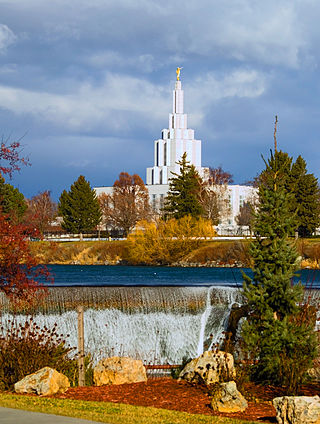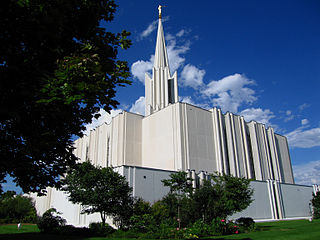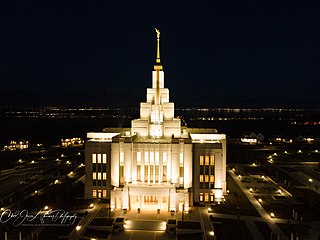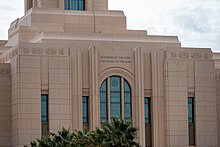
The Idaho Falls Idaho Temple is a temple of the Church of Jesus Christ of Latter-day Saints in Idaho Falls, Idaho. The intent to build the temple was announced on March 3, 1937, by church president Heber J. Grant during the church's general conference. It is the church's tenth constructed and eighth operating temple, the first built in Idaho, and the first built with a modern single-spire design.

The Jordan River Utah Temple is the 20th operating temple of the Church of Jesus Christ of Latter-day Saints, located in South Jordan, Utah. The intent to build the temple was announced on February 3, 1978, by church president Spencer W. Kimball during a press conference in the Church Office Building. The temple is the first in the city of South Jordan, the fifth in Salt Lake County, and as of 2024 is one of twenty-eight in the state of Utah.
Below is a chronological list of temples of the Church of Jesus Christ of Latter-day Saints with sortable columns. In the LDS Church, a temple is a building dedicated to be a House of the Lord and considered by church members to be the most sacred structures on earth. Upon completion, temples are usually open to the public for a short period of time, and then each is dedicated as a "House of the Lord," after which only members with a current temple recommend are permitted to enter. Thus, they are not churches or meetinghouses, but rather specialized places of worship. The LDS Church has 350 temples in various phases, which includes 191 dedicated temples, 50 under construction, and 109 others announced. Within temples, members of the LDS Church make covenants, receive instructions, and perform rituals and ordinances. Additionally, members consider the temple a place to commune with God, seek God's aid, understand God's will, and receive personal revelation.

The Gilbert Arizona Temple is a temple of the Church of Jesus Christ of Latter-day Saints, located at 3301 South Greenfield Road at the corner of East Pecos Road in Gilbert, Arizona. A groundbreaking, to signify beginning of construction, was held in 2010 and the temple was dedicated in 2014.

The Church of Jesus Christ of Latter-day Saints in Utah refers to the Church of Jesus Christ of Latter-day Saints and its members in Utah. Utah has more church members than any other U.S. state or country. The LDS Church is also the largest denomination in Utah.

The Church of Jesus Christ of Latter-day Saints in Idaho refers to the Church of Jesus Christ of Latter-day Saints and its members in Idaho. Rexburg, Idaho is home to Brigham Young University–Idaho. Idaho has the third most church members of any U.S. state, and the second-highest percentage of members. The LDS Church is the largest denomination in Idaho, with the largest presence in Eastern Idaho.
The Urdaneta Philippines Temple is the 190th temple of the Church of Jesus Christ of Latter-day Saints in Urdaneta City, Pangasinan, Philippines. The intent to build the temple was announced on October 2, 2010, by church president Thomas S. Monson, during the church's general conference. The temple is the third in the Philippines, following those in Manila and Cebu City.

The Cedar City Temple is a temple of the Church of Jesus Christ of Latter-day Saints in Cedar City, Utah, United States. The intent to construct the temple was announced by church president Thomas S. Monson on April 6, 2013, during the church's semi-annual general conference. The temple was announced concurrently with the Rio de Janeiro Brazil Temple; at the time, the announcement brought the total number of temples worldwide to 170. It is the 17th temple to be built in Utah.

The Saratoga Springs Utah Temple is a temple of the Church of Jesus Christ of Latter-day Saints in Saratoga Springs, Utah.

The Layton Utah Temple is a temple of the Church of Jesus Christ of Latter-day Saints under construction in Layton, Utah. The intent to construct the temple was announced by church president Russell M. Nelson on April 1, 2018, during the 188th general conference. The Layton Utah Temple was announced concurrently with 6 other temples. At the time, the number of total operating or announced temples was 189. It is the 22nd temple in Utah and the second temple in Davis County.
The Yigo Guam Temple is a temple of the Church of Jesus Christ of Latter-day Saints in Yigo, Guam.

The Bentonville Arkansas Temple is a temple of the Church of Jesus Christ of Latter-day Saints located in Bentonville, Arkansas. The Bentonville Arkansas Temple is the LDS Church's first temple in the state of Arkansas, and the 181st dedicated temple in operation worldwide.

The Orem Utah Temple is a temple of the Church of Jesus Christ of Latter-day Saints located in Orem, Utah. The intent to build the temple was announced on October 5, 2019, by church president Russell M. Nelson, during the church's general conference. The temple is the first in the city of Orem, the sixth in Utah County, and the 28th in the state of Utah.
The Puebla Mexico Temple is a temple of the Church of Jesus Christ of Latter-day Saints in Puebla, Mexico.
The Feather River California Temple is a temple of the Church of Jesus Christ of Latter-day Saints in Yuba City, California.

The Richmond Virginia Temple is the 177th operating temple of the Church of Jesus Christ of Latter-day Saints in Glenn Allen, Virginia, a suburb of Richmond. The Richmond Temple is the church's first temple in the state of Virginia.
The Salta Argentina Temple is a temple of the Church of Jesus Christ of Latter-day Saints under construction in Salta, Argentina.

The Taylorsville Utah Temple is a temple awaiting dedication of the Church of Jesus Christ of Latter-day Saints in Taylorsville, Utah. Plans to construct the temple were announced on October 5, 2019 by church president Russell M. Nelson, during the church's general conference. The temple is the first in the city of Taylorsville, the fifth in Salt Lake County, and the twenty-third in the state of Utah.
The Cobán Guatemala Temple is a temple of the Church of Jesus Christ of Latter-day Saints that is being built in Cobán's 2nd ward. It will be Guatemala's third temple, with the two other ones being the Guatemala City Guatemala and Quetzaltenango Guatemala temples.























